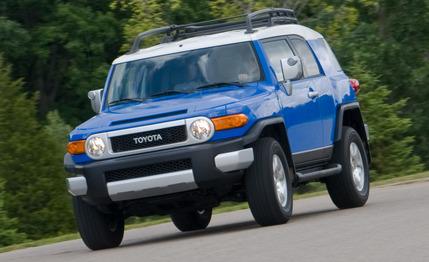 Short Take Road Test
Short Take Road Test
When it was introduced for 2007, the FJ Cruiser added some flair to Toyota’s conservatively designed lineup. A throwback to the much-celebrated FJ40, which was sold in the U.S. from 1960 to 1983, the new FJ shares its platform and many other parts with the current 4Runner. Like its ancestor, the FJ Cruiser is designed to keep on truckin’ when the pavement ends.
Some Road Manners

Previously, we had only tested the FJ with a six-speed manual transmission and placed it third out of four SUVs in a hard-core Death Valley comparison test. We praised the FJ for its off-road abilities, including 9.6 inches of ground clearance and some of the best approach and departure angles in the segment. But then, like now, it didn’t quite have the on-road chops to cut it as an everyday vehicle.
Driving the FJ is a lot like piloting a boat. The 4.0-liter V-6 with 239 hp and 278 lb-ft of torque does a good job of moving the 4338-pound ute, but executing dynamic maneuvers is a different story entirely. The FJ’s tall, boxy shape combined with the soft, off-road-compliant suspension and big tires leads to significant body roll, which is reflected in a poor 0.70 g of skidpad grip. Get on the gas, and the five-speed automatic’s well-spaced ratios allow a hustle to 60 mph in 7.3 seconds. When the throttle is pegged, the FJ’s front lifts like it’s trying to plane on water; stomping on the brakes makes it dive like a submarine, with stops from 70 mph taking 190 ft of real estate. Considering its size and wind-catching shape, our test average of 17 mpg wasn’t too bad, sitting between the EPA’s 16 mpg city/20 mpg highway ratings.
Visibility from inside the FJ is also cause for concern. Slender, vertical side mirrors make lateral visibility tough, and the giant C-pillars and the short windows make checking the large blind spots nearly impossible. We highly recommend opting for the $2175 Convenience package that offers keyless entry, cruise control, power mirrors, tinted glass, a rear wiper, and—most important—a backup camera.
Funky Design
The FJ was created to serve a purpose away from the road and is modeled after the original FJ, both of which lead to its controversial styling. The love-it-or-hate-it look of the exterior carries over inside. The build quality is decent and there are plenty of storage cubbies, but the temperature-control knobs look like they belong on a Lego Duplo play table. The handle for the rear half-doors is hidden on the inside of the door panel, making them difficult to open. Once you access the rear, the seats are comfortable during short trips and can be folded down to provide 67 cubic feet of cargo space, enough for a trip to Ikea. The front seats provide good support for extended jaunts, but we wish the steering column would telescope for a bit more comfort. On the plus side, if your journey should take a muddy route, the plastic floor coverings are a breeze to clean up.
Our tester came equipped with an upgraded nine-speaker stereo (part of the $2720 Upgrade Package 2), which left us disappointed. It was as if the system were never tuned inside the plastic interior and the subwoofer were out of phase with the rest of the speakers. There is a button to deactivate the sub entirely, but doing so leaves the system sounding like a decade-old clock radio.
What Does the Future Hold?
The fate of a next-generation FJ is unknown, but we do know that 2010 models get an updated 4.0-liter V-6 with 19 more horsepower for a total of 258. A new Special Edition model will be available and should offer greater off-road prowess with Bilstein shocks, skid plates, TRD wheels, and a Garmin navigation system tailored to the trails.
The FJ is still somewhat of a misfit in the Toyota range and its segment. It sacrifices on-road competence, visibility, and interior comfort for off-road ability and style. It’s not the practical transportation appliance we’ve come to expect from Toyota, and although we admire its quirkiness—it has three windshield wipers—we can’t quite wrap our heads around this brick on wheels.